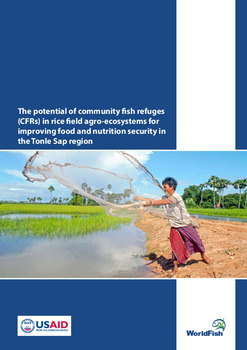The potential of community fish refuges (CFRs) in rice field agro-ecosystems for improving food and nutrition security in the Tonle Sap region

Citation
Brooks, A.; Sieu, C. (2016). The potential of community fish refuges (CFRs) in rice field agro-ecosystems for improving food and nutrition security in the Tonle Sap region. Penang, Malaysia: WorldFish. Program Report: 2016-10
The fisheries sector in Cambodia contributes 8%-12% to national GDP and 25% - 30% to agricultural GDP, with an estimated 4.5 million people involved in fishing and associated trades. Fish and other aquatic animals are important food sources, contributing an estimated national average of 60% - 70% of total animal protein intake. Of the 2013 total fish production, 550,000 metric tons were harvested from freshwater habitats, of which rice field fisheries and small-scale family fisheries contributed approximately 20%. The productivity and value of rice field fisheries to households in rural Cambodia has been highlighted in a number of previous studies. The Fisheries Administration of the Ministry of Agriculture, Forestry and Fisheries plans to increase productivity from rice field fisheries and aquaculture at an annual rate of 15% to maintain supply for a growing population. This report draws mainly on the baseline and monitoring data from the Rice Field Fisheries Enhancement Project (RFFEP) during its implementation between 2012 and 2014. Reference is also made to the Fish on Farms project to highlight the relative contribution of fish from small-scale aquaculture compared to wild-caught fish.
Permalink
Date Available
Type
Countries
Copyright
CC BY 4.0
Research Themes